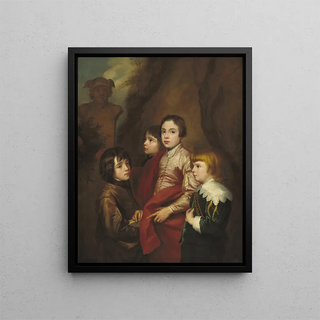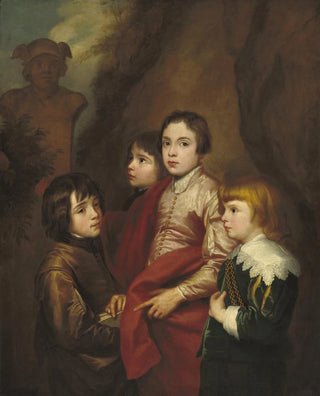Painting Group of Four Boys - School of Antoine van Dyck | Art print


View from behind

Frame (optional)
In the rich and varied panorama of art history, certain works stand out for their ability to capture not only figures but also emotions and cultural contexts. The art print of the "Groupe de quatre garçons" from the Antoine van Dyck School is a perfect example. This 17th-century painting, emblematic of its time, evokes youth and carefree innocence, while demonstrating impressive technical mastery. Contemplating this piece, the viewer is transported to a world where light, color, and composition combine to bring to life vibrant characters full of realism and dynamism.
Style and uniqueness of the work
The style of "Groupe de quatre garçons" is characteristic of Antoine van Dyck's baroque approach, where fluid lines and rich colors intertwine to create an atmosphere that is both intimate and grandiose. The figures, although depicted in an informal setting, are draped with an elegance that highlights their social status. Each boy, with his unique expression and carefully chosen posture, seems to tell a story, a frozen anecdote in time. The soft, diffuse light subtly illuminates the faces, accentuating the details of clothing and features. This art print is not merely a depiction of young boys but a tribute to the vitality of youth, friendship, and camaraderie—universal themes that resonate across ages.
The artist and his influence
Antoine van Dyck, a pupil of Rubens, established himself as one of the great masters of portraiture in the 17th century. His influence on European art is undeniable, notably through his ability to blend realism and idealization. As a court portraitist, he captured the very essence of his subjects, transforming historical figures into timeless icons. The art print of the "Groupe de quatre garçons" perfectly illustrates this mastery, where every detail is carefully considered to reflect not only physical appearance but also the personality of the young boys. Van Dyck paved the way for many artists who followed, inspiring generations to explore the complexity of human emotions.

Matte finish

View from behind

Frame (optional)
In the rich and varied panorama of art history, certain works stand out for their ability to capture not only figures but also emotions and cultural contexts. The art print of the "Groupe de quatre garçons" from the Antoine van Dyck School is a perfect example. This 17th-century painting, emblematic of its time, evokes youth and carefree innocence, while demonstrating impressive technical mastery. Contemplating this piece, the viewer is transported to a world where light, color, and composition combine to bring to life vibrant characters full of realism and dynamism.
Style and uniqueness of the work
The style of "Groupe de quatre garçons" is characteristic of Antoine van Dyck's baroque approach, where fluid lines and rich colors intertwine to create an atmosphere that is both intimate and grandiose. The figures, although depicted in an informal setting, are draped with an elegance that highlights their social status. Each boy, with his unique expression and carefully chosen posture, seems to tell a story, a frozen anecdote in time. The soft, diffuse light subtly illuminates the faces, accentuating the details of clothing and features. This art print is not merely a depiction of young boys but a tribute to the vitality of youth, friendship, and camaraderie—universal themes that resonate across ages.
The artist and his influence
Antoine van Dyck, a pupil of Rubens, established himself as one of the great masters of portraiture in the 17th century. His influence on European art is undeniable, notably through his ability to blend realism and idealization. As a court portraitist, he captured the very essence of his subjects, transforming historical figures into timeless icons. The art print of the "Groupe de quatre garçons" perfectly illustrates this mastery, where every detail is carefully considered to reflect not only physical appearance but also the personality of the young boys. Van Dyck paved the way for many artists who followed, inspiring generations to explore the complexity of human emotions.
12,34 €






